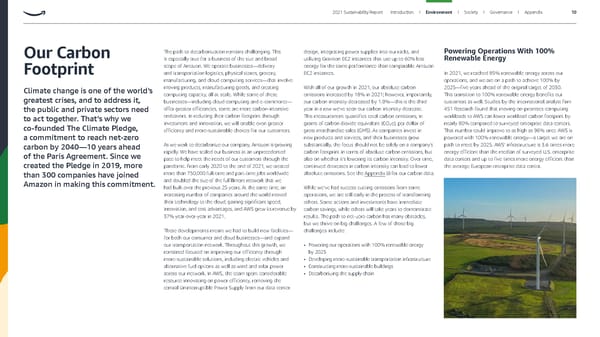Our Carbon Footprint Climate change is one of the world’s greatest crises, and to address it, the public and private sectors need to act together. That’s why we co-founded The Climate Pledge, a commitment to reach net-zero carbon by 2040—10 years ahead of the Paris Agreement. Since we created the Pledge in 2019, more than 300 companies have joined Amazon in making this commitment. The path to decarbonization remains challenging. This is especially true for a business of the size and broad scope of Amazon. We operate businesses—delivery and transportation logistics, physical stores, grocery, manufacturing, and cloud computing services—that involve moving products, manufacturing goods, and creating computing capacity, all at scale. While some of these businesses—including cloud computing and e-commerce— offer greater efficiencies, some are more carbon-intensive endeavors. In reducing their carbon footprint through investment and innovation, we will enable even greater efficiency and more-sustainable choices for our customers. As we work to decarbonize our company, Amazon is growing rapidly. We have scaled our business at an unprecedented pace to help meet the needs of our customers through the pandemic. From early 2020 to the end of 2021, we created more than 750,000 full-time and part-time jobs worldwide and doubled the size of the fulfillment network that we had built over the previous 25 years. At the same time, an increasing number of companies around the world moved their technology to the cloud, gaining significant speed, innovation, and cost advantages, and AWS grew its revenue by 37% year-over-year in 2021. These developments meant we had to build new facilities— for both our consumer and cloud businesses—and expand our transportation network. Throughout this growth, we remained focused on improving our efficiency through more-sustainable solutions, including electric vehicles and alternative fuel options as well as wind and solar power across our network. In AWS, the team spent considerable resource innovating on power efficiency, removing the central Uninterruptible Power Supply from our data center design, integrating power supplies into our racks, and utilizing Graviton EC2 instances that use up to 60% less energy for the same performance than comparable Amazon EC2 instances. With all of our growth in 2021, our absolute carbon emissions increased by 18% in 2021; however, importantly, our carbon intensity decreased by 1.9%—this is the third year in a row we’ve seen our carbon intensity decrease. This measurement quantifies total carbon emissions, in grams of carbon dioxide equivalent (CO₂e), per dollar of gross merchandise sales (GMS). As companies invest in new products and services, and their businesses grow substantially, the focus should not be solely on a company’s carbon footprint in terms of absolute carbon emissions, but also on whether it’s lowering its carbon intensity. Over time, continued decreases in carbon intensity can lead to lower absolute emissions. See the Appendix for our carbon data. While we’ve had success cutting emissions from some operations, we are still early in the process of transforming others. Some actions and investments have immediate carbon savings, while others will take years to demonstrate results. The path to net-zero carbon has many obstacles, but we thrive on big challenges. A few of those big challenges include: • Powering our operations with 100% renewable energy by 2025 • Developing more-sustainable transportation infrastructure • Constructing more-sustainable buildings • Decarbonizing the supply chain Powering Operations With 100% Renewable Energy In 2021, we reached 85% renewable energy across our operations, and we are on a path to achieve 100% by 2025—five years ahead of the original target of 2030. This transition to 100% renewable energy benefits our customers as well. Studies by the international analyst firm 451 Research found that moving on-premises computing workloads to AWS can lower workload carbon footprint by nearly 80% compared to surveyed enterprise data centers. That number could improve to as high as 96% once AWS is powered with 100% renewable energy—a target we are on path to meet by 2025. AWS’ infrastructure is 3.6 times more energy efficient than the median of surveyed U.S. enterprise data centers and up to five times more energy efficient than the average European enterprise data center. 2021 Sustainability Report Introduction I Environment I Society I Governance I Appendix 10
 ESG Report | Amazon Page 9 Page 11
ESG Report | Amazon Page 9 Page 11